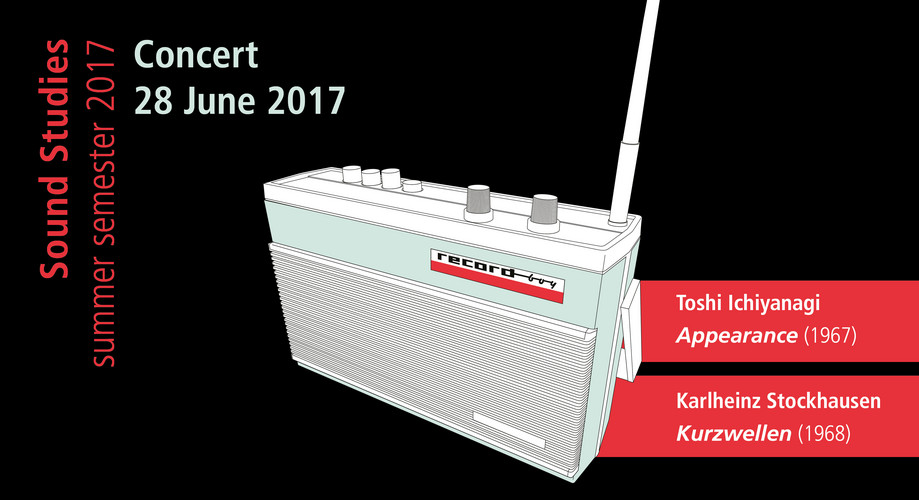
Sound Studies Summer Semester Concert 2017 © Kathrin Scheidt
Our Summer Semester 2017 concert features a group of Sound Studies students performing a reinterpretation of „Kurzwellen“, a Stockhausen’s composition (1968) based on the peculiar sound characteristics of short-wave radios and „Appearance“ by Toshi Ichiyanagi (1967).
Sound Studies – Summer Semester concert 2017
Toshi Ichiyanagi – Appearance (1967)
Karlheinz Stockhausen – Kurzwellen (1968)
28.6.2017 | 19.00 Uhr
Georg-Neumann-Saal, UdK
Einsteinufer 43-53
10587 Berlin
Entrance is free
This concert is made possible with the friendly support of the Jazz Institute Berlin, UdK.
Karl Heinz Stockhausen – Kurzwellen
A group of students of the MA Sound Studies perform a reinterpretation of ‚Kurzwellen‘, Stockhausen’s composition dated 1968 and based on the peculiar sound characteristics of short-wave radios.Four musicians, each equipped with an instrument and a specifically designed short-wave simulator, engage in an intricate collective performance, imitating and transforming each others output in a process of improvised musical metamorphosis. At the same time a fifth performer takes care of the filtering and positioning of the sounds over 8 speakers, circularly disposed in the room.The improvisational character of the piece generates every time a new outcome, following the composers notation yet ultimately raising from the connections between the members of the ensemble.
Elektronium: monophoner synthesizer „XY“, Edoardo Calgari, Lena H.
Tamtam: metal sheet, Edoardo Calgari, Lena H.
Viola: electric guitar, Alejandra Cardenas, Carlos Ortiz
Piano: Carlos Villamizar, Arina Korenyu
Filter & Spatialization: Software MaxMSP-Patch, Oliver Hahn, Max Joy
Toshi Ichiyanagi – Appearance –
For 3 Instruments, 2 Oscillators, 2 Ring Modulators
The Japanese composer Toshi Ichiyanagi played an important role in the New York avant-garde scene in the late 50s. He was connected to John Cage and considered as a „mentor“ to the Fluxus movement. His piece „Appearance“ (1967) is a composition for instruments, oscillators and ring modulators. It is representative for Ichiyanagis idea of „live-electronic-music“ and based on an interactional structure for the players without leaving aside the factor of unpredictability. Since hearing is preferred to expressing by Ichiyanagi, improvisation has to be started with careful hearing of the space. Some freedom has been taken regarding the instrumentation. One of the major differences with the historical versions is that the ring modulators are emulated in a digital way thanks to a max-patch. Also, one of the versions will be played with a saxophone and a Shrutibox.
The piece will be performed twice, by two different groups with a slightly different instrumentation.
Contrabass: Steven Boreham, Maxi Schmidt
Grand Piano/ Harmonium: Johannes, Aude Gouaux Langlois
Trumpet/ Saxophone: Linda Sykora, Jonas Wiese
OSC 1: Julio Lugon, Felipe Vaz
OSC 2: Florian T M Zeisig, Luciana Da Costa Amorim,
Grand Piano/ Shrutibox: Johannes Stegemann, Aude Gouaux Langlois
Trumpet/ Saxophone: Linda Sykora, Jonas Wiese
OP: Nicolas Rosero Sanchez, Jonas Engelmann

